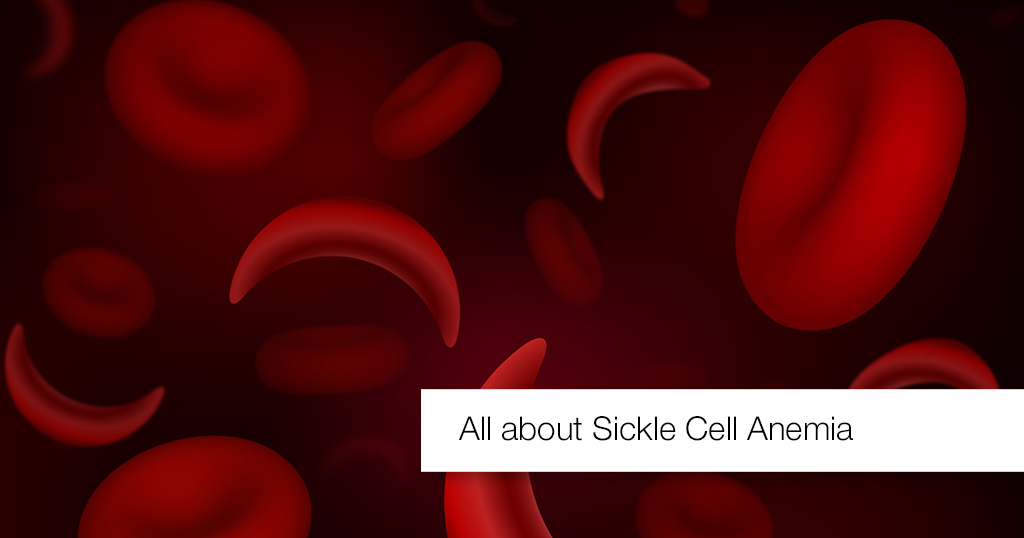All about Sickle Cell Anemia


Overview
Sickle cell anemia is an inherited blood disorder that causes chronic destruction of red blood cells, episodes of intense pain, vulnerability to infections, organ damage, and, in some cases, early death. Sickle cell anemia is most common in people whose ancestors came from parts of Africa, Saudi Arabia, India and the Mediterranean region. To have a fully developed case of sickle cell anemia, one gene for the illness must be inherited from both parents. When a person inherits only one sickle cell gene from one parent, that person is said to have sickle cell “trait” rather than sickle cell anemia. People with sickle cell trait usually have no symptoms of sickle cell anemia, but they can pass the gene for sickle cell hemoglobin to their children.
What is Sickle Cell Anemia?
People with sickle cell anemia have inherited genes for a type of hemoglobin (hemoglobin S) that forms long rods when it gives up its oxygen. Red blood cells typically are disc-shaped. The long rods are located inside the red blood cells, and stretch the red cells into sharp, abnormal “sickle” shapes. Sickle-shaped red blood cells cannot pass through the body’s blood vessels easily. Instead, they clog blood vessels, block the flow of blood, and cut off the oxygen supply to tissues and organs. This lack of oxygen can damage the body’s organs and limbs, and it causes severe pain in any affected area.
Also, since sickled blood cells last only 10 to 20 days in the bloodstream, compared with a normal red cell’s lifespan of 120 days, sickling causes chronic anemia, abnormally low levels of red blood cells. People with sickle cell disease also have an increased risk of developing life-threatening infections, because the spleen, which helps clear infections, is usually destroyed by the time the patient is 2 to 4 years old.
Painful sickle cell crises
When sickled red cells block blood vessels, the oxygen supply to body cells is cut off, causing painful episodes called crises. Painful sickle cell crises can affect many different joints and body organs, but the back, chest, extremities and abdomen are affected most commonly. The level of pain varies, from trivial to excruciating. In about half the cases, the pain crisis is accompanied by fever, swelling, tenderness, nausea, vomiting, high blood pressure and a fast heart rate. Typically, the episodes last from 2-7 days.
In the hands and feet, the blockage of blood vessels may cause pain, swelling and fever, a condition called hand-foot syndrome. In the lungs, sickled cells and infection can lead to chest pain and fever, a life-threatening condition called acute chest syndrome.
These painful episodes can be triggered by many factors, such as infection, stress, alcohol consumption, menses and dehydration, but the majority of events have no identifiable cause.
Symptoms of Sickle Cell Anemia?
Symptoms of sickle cell anemia include:
- Symptoms of anemia, including fatigue, shortness of breath, pale skin and fingernails
- Jaundice, yellowing of skin and whites of eyes
- Slowed growth and delayed puberty in children
- Frequent infections
- Eye problems, including blindness
- Stroke
Diagnosing Sickle Cell Anemia
Your physician will enquire about a history of painful crises, neurological problems, chest pain and history of infections. He/she may then perform a physical examination, focusing on your heart, lungs, joints, eyes and the neurological system. A blood test called a complete blood count can detect anemia, and a microscopic examination of the blood may reveal the characteristic sickled cells. Doctors diagnose sickle cell anemia by using a blood test called hemoglobin electrophoresis.
Since sickle cell anemia is an inherited disorder that is present from birth, your doctor may perform a routine blood test to screen for the disorder whenever a new baby is born in your family. Prenatal screening also can be done. In infants who have not been screened, an episode of hand-foot syndrome may be the first sign that your child has sickle cell anemia.
Treatment for Sickle Cell Anemia
Supportive Treatment
Sickle cell anemia treatment may include any of the following:
- Dietary supplements like Folic acid supplements to ensure that helps stimulate the production of red blood cells
- Vaccinations for pneumococcal pneumonia, Haemophilus influenza, hepatitis and influenza to prevent infections
- Regular antibiotic therapy to protect against infection (in young children)
- Fluids, oxygen and pain medications (L-glutamine oral powder) during episodes of painful crisis
- Blood transfusions to treat anemia and prevent stroke, if anaemia is severe or persistent
- Hydrea (Hydroxyurea) in adults: This medication may reduce the need for blood transfusions, while reducing the frequency of painful crises and acute chest syndrome
Curative Treatment
Stem cell transplant or Bone Marrow Transplant (BMT): Stem cell transplant, also called Bone Marrow Transplant (BMT) is a procedure that involves replacing the bone marrow (spongy, fatty tissue that houses blood stem cells) affected by sickle cell anemia with a healthy bone marrow given through a drip into a vein from a donor. Preferred donor for BMT are HLA identical siblings followed by HLA identical unrelated or haploidentical donor. In past only symptomatic patients with HLA identical donor’s were found to be suitable donors but in recent years, lot of progress has been made owing to which HLA identical donors or haploidentical (Half HLA match siblings or parents) can also be used as donors with very good outcomes.
In current times, any child who is in need of BMT can safely be offered transplant using one of other donor. There is no age for BMT but as a general rule, the sooner it can be offered to any symptomatic patient, the better are the outcomes.
When to see a Doctor?
People with sickle cell disease must schedule regular doctor visits and receive comprehensive care. Call your doctor immediately when you or a loved ones with sickle cell disease develops a fever (or any other signs of infection), develop breathing problems, have severe pain in any part of the body, or develops any neurological symptoms.
Request an appointment at Apollo Hospitals
Call 1860-500-1066 to book an appointment
Stem cell transplant or Bone Marrow Transplant (BMT) at Apollo Hospitals:
Apollo Hospitals have a comprehensive BMT Service. Key features of BMT Services include:
- Internationally renowned BMT Physicians (The center has the credit of doing one of the maximum number of BMT’s for SCD in the world with one of the best outcomes at par with any European or American center).
- State-of-the-art BMT unit
- Dedicated Nursing Service
- Pre and post-BMT counselling and support-service
- Patient and family education and support
- HLA-Typing laboratory and flow cytometry stem cell counting
- Harvesting and storage of blood stem cells for BMT at a later date
- RT PCR for diagnosing Post-BMT infections
- Multi-disciplinary support services
© Copyright 2024. Apollo Hospitals Group. All Rights Reserved.
 +91 8069991061
Book Health Check-up
+91 8069991061
Book Health Check-up







